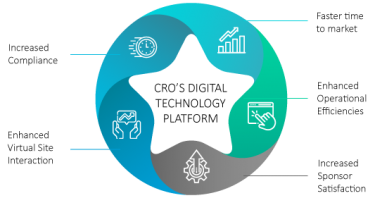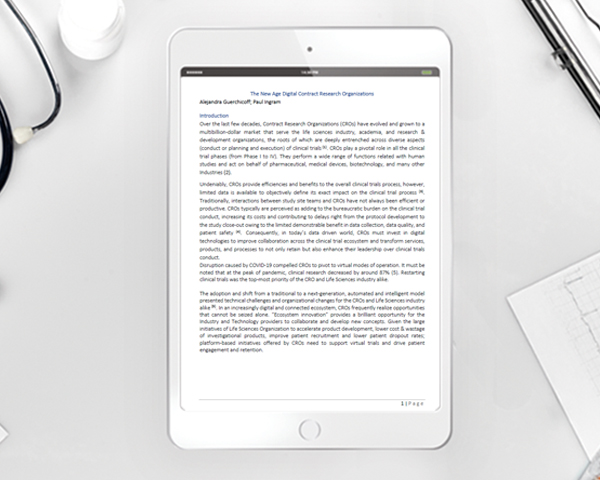Whitepaper: The new age digital contract research organisations
Posted: 17 December 2021 | TCS ADD | No comments yet
The ideal CRO digital platform offers an opportunity to un-burden bureaucracy and drive data capture and integrity straight into the digital eco-system allowing earlier intervention.
Alejandra Guerchicoff; Paul Ingram
Introduction
Over the last few decades, Contract Research Organizations (CROs) have evolved and grown to a multibillion-dollar market that serve the life sciences industry, academia, and research & development organizations, the roots of which are deeply entrenched across diverse aspects (conduct or planning and execution) of clinical trials (1). CROs play a pivotal role in all the clinical trial phases (from Phase I to IV). They perform a wide range of functions related with human studies and act on behalf of pharmaceutical, medical devices, biotechnology, and many other Industries (2).
Undeniably, CROs provide efficiencies and benefits to the overall clinical trials process, however, limited data is available to objectively define its exact impact on the clinical trial process (3). Traditionally, interactions between study site teams and CROs have not always been efficient or productive. CROs typically are perceived as adding to the bureaucratic burden on the clinical trial conduct, increasing its costs and contributing to delays right from the protocol development to the study close-out owing to the limited demonstrable benefit in data collection, data quality, and patient safety (4). Consequently, in today’s data driven world, CROs must invest in digital technologies to improve collaboration across the clinical trial ecosystem and transform services, products, and processes to not only retain but also enhance their leadership over clinical trials conduct.
Disruption caused by COVID-19 compelled CROs to pivot to virtual modes of operation. It must be noted that at the peak of pandemic, clinical research decreased by around 87% (5). Restarting clinical trials was the top-most priority of the CRO and Life Sciences industry alike.
The adoption and shift from a traditional to a next-generation, automated and intelligent model presented technical challenges and organizational changes for the CROs and Life Sciences industry alike (5). In an increasingly digital and connected ecosystem, CROs frequently realize opportunities that cannot be seized alone. “Ecosystem innovation” provides a brilliant opportunity for the Industry and Technology providers to collaborate and develop new concepts. Given the large initiatives of Life Sciences Organization to accelerate product development, lower cost & wastage of investigational products, improve patient recruitment and lower patient dropout rates; platform-based initiatives offered by CROs need to support virtual trials and drive patient engagement and retention.


Fig 1: Key Tenets of a Digital Technology Platform
Digital Transformation: Lower risk, higher control
Any digital transformation approach by the CRO must encompass domain expertise combined with the technical capabilities that enhances agility, speed, and data-driven decision making. So how can this be successfully accomplished? The answer lies in creating a vision for future technology adoption and building technology and human skills that help in its execution.
However, transformation seldom happens in a single step. True transformational initiatives succeed when they are incremental, cost-effective, and sustainable. CROs must therefore focus on realizing outcomes including new digital platforms, improved processes, enhanced operations and build capabilities accordingly, thereby realizing superior business value for the pharma.
Following are the key areas that CROs need to find practical solutions to with new digital, cognitive, and advanced platforms and spearhead the next-generation CRO model.
An Agnostic Digital Platform
The need for a digital platform that can serve any sponsor has never been greater. The industry is looking for technology solutions that enables seamless and simultaneous onboarding of multiple projects and sponsors from any therapeutic area and at any point in the product life cycle, and in many instances, for multiple Sponsors at the same time.
Contract Research Organizations are now seeking to build digital platforms that integrate with existing systems in a plug and play model. An inordinate delay is usually observed when setting up new projects and interfacing with sponsor databases platform able to allow interoperable data exchange, and able to generate a single digital eco-system cloud -based solution it is the key solution. Only with adoption of an effective, purpose-built, and unified cognitive digital platform technology will we be able to truly modernize CRO’s operations.
Execute traditional, virtual, and hybrid clinical studies: The global pandemic confronted CROs with challenges not experienced before and its outcome is driving requirements to modernize the current clinical trials landscape. This resulted in an acceleration of innovation across many areas, most notably, the elevated demand for digital and virtual capabilities to enable study continuity. Sponsors require their CRO partners to deliver their trial design and objectives covering each extreme from traditional to virtual and everything in between. However, it is important to realize that not every trial is suitable for a virtual methodology, but that nearly every study has at least some aspects that can benefit from these methods. As such, flexibility of the CRO’s digital platform to adapt to all configurable designs is non-negotiable. Needs of varied trial formats are met with flexible, robust validated platforms possessing back end coded functionalities and configurable features.
Build integrated digital network of partners: CROs must focus on building a collaborative and cross functional digital ecosystem that supports the development of a network of partners. Moving forward, platforms being used by CRO’s need to support open integrations with the potential to deliver specific digital ecosystem for each sponsor. As each sponsor builds out their digitalization strategy across a common platform, it drives the platform to evolve by adding more partners to the network. CROs can assist in facilitating an integrated network of partners, with access to different sponsor projects, sites, information, investigators, and patients. The technology also enables CROs with an operational environment to discuss and understand the safety and clinical endpoint assessments to assist in the progressive evolution of clinical trials. The new technology needs to be an inclusive and able to build strong partnerships to drive clinical trials into a new era that meets the needs of all involved.
Easy Configuration & Flexibility
Adopting an AI system is a journey involving iterative design, development, testing and delivery. The configurable and flexible model reduces implementation time and improves the quality of the solution. It involves constant monitoring and supervision of models, the performance and accuracy metrics of which keep evolving. Configuration management is the key tool where new projects can be onboarded easily and with minimal or no technical assistance for the CRO from external technology provider. The new generation digital platforms possess not only a higher processing power of data, and usage of data analytics and artificial intelligence but also offers the possibility of re-use of objects and templates across projects and studies. The AI based platform should be 100% configurable and flexible to meet the sponsor requirements. CROs and technology providers can accelerate and improve customization by combining configurable platforms with off-the-shelf toolsets tailored to the systems.
Adapt to Existing CRO’s Landscape and Operations
CROs need to draw a clear transformation and adoption strategy when envisioning a digital platform. While the new purpose-built technology and virtual research management model offer the tools and the right processes to help modernize clinical research, the operation disruption risks must be minimized throughout the transition phase. CROs must rapidly innovate and lower the platform adoption gaps. The COVID-19 situation caused considerable near-term disruption with the number of new patients entering clinical trials worldwide falling by 79% in April 2020. Sponsors were forced to pause more than 2,000 clinical trials because of COVID-19 (6). The industry now, has no room for further disruptions hence is now required to re-start the stalled programs adhering to tight timelines.
Plug and play approach in the digital eco-system allows quicker integration and flexibility when adopting new technologies while continuing to use current systems. Ideally a CRO will have a platform approach that allows integration with existing/legacy systems that serves as a preferred data source. This approach ensures functioning of CRO operations with minimal disruption across any configuration, for any sponsor, geography and for any molecule in development.
Improve the KPI Analysis and Lower the Services Efforts on Producing KPI Metrics
Platforms that integrate into the CRO digital ecosystem drive up their value and benefits to sponsors by enabling the client’s project delivery to be measured and managed through meaningful end-to-end real-time key performance indicators (KPIs). Critical areas needing resource or attention to stay on track, or get back on track, allow the CRO partnerships to manage their way to success; and out of trouble whenever required.
Ensure Enhanced Compliance
Agility of the platform moves away from many cycles of review, managing the process through reporting and alerts to ensure compliance and towards procedures that build business process and regulatory compliance. This allows key response times for compliance (such as reporting safety events) driven by information led pro-activity rather than post-event reactivity. It allows higher risk or impact factors in a project to be highlighted sooner when things move outside their normal/acceptable parameters by providing meaningful insights & prevention.
Data Security
The Security, IT Service Continuity Management, recovery, and contingency plan considerations, should be clearly detailed by the Technology provider, including a description of how access to critical infrastructure, business data, and Personal Information (PI) data will be handled. Additionally, the multi-tenant nature of digital platforms requires a heightened focus on ensuring that every effort is made to isolate tenant data and resources. PI data is the most valuable asset in clinical studies and for sponsors and to protect its confidentiality, privacy, integrity, and availability has to be always a topmost priority. Implementation of a security management system that includes information security policies, requirements, globally recognized standards, procedures, and guidelines need to be in place and in compliance with regulatory requirements and sponsor policies. The onus of providing a robust infrastructure that controls information security of data and driving compliance to security policy/procedures lies with the CROs and technology providers.
Cost-value of technology
Clinical trials operational management complexity continues to increase because of globalization, protocol design, growth of decentralized models, demand for patient-centricity among several other factors. As trial management’s complexity increases, CROs need to look for solutions that can overcome these challenges. Digital technology in the form of innovative platforms offer the support to ensure end-to-end management optimization, from discovery to market product approval at a cost-value positive strategy. The value these digital platforms bring can be judged by supporting fast study start-up and go/no-go decisions at lower overall cost while increasing efficiencies & reduced workload to achieve outcomes. CRO’s with platforms that drive efficiencies in navigating the development and marketing approval process will evolve to be the go-to partners in future.
CROs sit between the sponsor and the technology providers. Technology providers would need to be creative in the way CRO’s buy their services to reflect their business model. It is recommended for CRO’s to opt for subscription-based model for technology that enables customized crafting of platforms that meet specific needs.
Easy user interface and minimal user training efforts
Platforms can unify processes and point of data collection into one system. In this way, it reduces the number of systems interface each stakeholder has to learn and use. This in turn reduces the training burden for site staff and patients. Limiting the amount of change management by providing user interface (UI) reductions is also an attractive upside of transitioning to platform level digital operations. User first, personalized engagement & easy-to-use platforms drive adoption by patients, sites and the CRO teams themselves. The digital transformation for a CRO should be focused on Minimum Viable User Experience (MVUE). A well-defined MVUE for all platform user roles, over the current focus on a minimum viable product of features on the Platform may be a successful strategy in reducing gaps in data, due to non-use or user non-compliance.
Conclusions
In an increasingly digital and connected environment, leaders of CROs and Life Science Industry frequently find themselves facing opportunities that they—or even their industries—cannot seize alone. CROs have always been one of the key decision makers in selecting the right technology for a study or sponsor. Now, more than ever, Life Science Industry and CROs are facing a new era of transformation and must look to reimagine existing processes to reduce cycles times and bring greater transparency, quality, efficiencies, and agility, to their organization.
The ideal CRO digital platform offers an opportunity to un-burden bureaucracy put upon sites today and drive data capture and integrity straight into the digital eco-system allowing earlier intervention, if required, or more rapid conclusion of trials to support registration or go/no-go decisions
These changes will require leadership vision and organizational change to drive the CRO transformation. Cloud technologies combined with digital and cognitive automation are the most advanced and practical solution to address the sponsor-CRO challenges, providing enhanced Clinical Trial operation management, faster time to market, and more importantly ensure patient access to better and more efficient products and treatments.
References
- References 1. Research and Markets. The new trends of global clinical development outsourcing market. Los Angeles: Business Wire; 2015. https://www.businesswire.com/news/home/20150130005621/en/Research-Markets-2015-Trends-Global-Clinical-Development#. Accessed Dec 2018.
- Search industry provider profiles. https://www.centerwatch.com/news-resources/industry-providers/services. Access date. Google Scholar
- Stewart DJ, Batist G, Kantarjian HM, et al. The urgent need for clinical research reform to permit faster, less expensive access to new therapies for lethal diseases. Clin Cancer Res. 2015; 21: 4561- 4568. Cross refCAS PubMed Web of Science ®Google Scholar
- Contract research organizations in oncology clinical research: Challenges and opportunities https://acsjournals.onlinelibrary.wiley.com/doi/full/10.1002/cncr.29994#cncr29994-bib-0004
- Clinical research cut 87% at peak of pandemic. PharmaTimes. 25th August 2020. https://www.pharmatimes.com/news/clinical_research_cut_87_at_peak_of_pandemic_1347290
- Clinical trials stopped by Covid-19. https://covid19.bgcarlisle.com/published/full-report-2021-01-29.html (2021).
About the authors
Alejandra Guerchicoff


Paul Ingram


Related content from this organisation
- TCS revolutionize clinical trial monitoring and data analysis with AR/VR-driven immersive analytics
- AI – A Game Changer in Unifying Clinical Data
- Whitepaper: Redefining Clinical Trial Decision-Making: Leveraging NLP for extracting insights from unstructured data
- Whitepaper: Rapid adoption of medication adherence and smart packages – key factors driving interest and consideration
- Whitepaper: A beginner’s guide to AI driven pharmacovigilance platform
Related topics
Artificial Intelligence, Biopharmaceuticals, Data integrity, Drug Delivery Systems, Informatics, Packaging, Regulation & Legislation, Research & Development (R&D), Supply Chain










